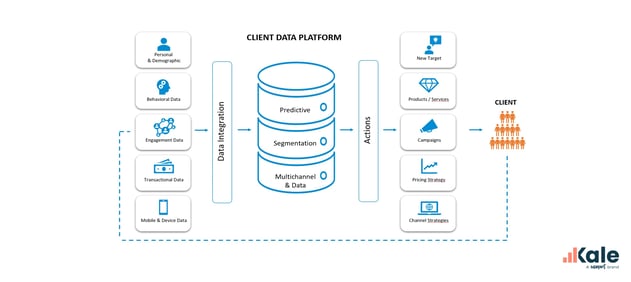Marketing is rapidly moving towards digitalisation and the exploitation of technology. Data-driven marketing is now much more than just a marketing discipline and practically all marketing strategies are already data-driven.

Many marketers are jumping —almost out of necessity— into the world of data. However, starting to think data-driven and implementing data-driven marketing strategies is a complex process. At the beginning of such processes, marketers and business managers often feel helpless and do not know where to start or how to approach the technical aspect of the process. Understanding what data-driven marketing is and what its premises are is essential.
Last Wednesday 14th of July Borja Martín, Kale's director, talked about data-driven marketing and explained the keys to accelerate business through data in the Webinar: Data-Driven Marketing. Watch it below:
What is Data-Driven Marketing?
As its name suggests, data-driven marketing is a marketing approach based on building marketing strategies, campaigns and actions around data about the customers, the market and the competitors, among others.
Data-driven marketing uses data analysis tools as one of its core methodologies to transform data into insights that contribute to the decision-making process and help companies differentiate from the competition and offer personalised content.
The basics of data-driven marketing
As we move into data-driven marketing, there are a number of considerations we should keep in mind:
- Customer perception is our reality. One of the premises of data-driven marketing is that the customer must be the axis of any organisation and their perceptions, our reality. If there is no customer, there is no business. If there is no business, data is useless. When we work with customers we have to understand that listening is much more important than talking and that dialogue is much more productive than simply sending them messages.
- All data is innocent until someone finds it interesting. Data plays a major role in data-driven marketing. However, data collection and analysis must always be subordinated to business objectives and strategies. There is no such thing as valid data or invalid data. The usefulness of data will depend on the characteristics of our business.
- Questions are never intrusive, answers are. Data-driven marketing goes far beyond data capture. It is essential to understand that any valuable information that we cannot get from data, we must ask the customer directly. Obviously, we must ask clients about things that interest them or in a way attractive enough for them to be willing to provide us with valuable answers.
- Create experiences that make sense. Beyond data, transmitting valuable and profitable experiences to all those who are part of the relational ecosystem with the consumer —the customers themselves, co-workers, partners, etc.— will help us build an environment of intelligence through which we can create better solutions for our customers.
In short, in data-driven marketing the client is important, customer data is essential and asking questions is always a good idea.
Data-driven marketing's recipe
If we compare data-driven marketing to a culinary recipe, we will find it easier to understand that the quality of the results depends on the quality of the ingredients.
In data-driven marketing, there are three ingredients we cannot do without:
1. Setting objectives. Having a clear vision of what data we need, how we are going to collect it and how we are going to apply it is meaningless if we do not align our strategy with a pre-established set of objectives. Within this framework of objectives, we must consider both business objectives and data objectives which will help us achieve the business objectives. To get somewhere, the first and most important step is to know where we want to get to.
If we are not clear about our goals and how we are going to use the data to achieve them, everything we do afterwards will be useless.
2. Activating the consumer voice within the organisation. To undertake a data-driven marketing strategy, the customer must be at the core of the business and their voice (Voice of the Customer) must be activated. In other words, we must build communication channels so that the customer can speak to us and their voice must be listened from all the areas of the company, not only from the marketing, sales or customer service departments.
3. Set metrics that matter. One of the pain points for many companies when they start working with data is that they do not know what information or metrics are important. In this sense, being clear about which metrics matter to us according to our business logic is crucial. Among other things, metrics help us figure out which data is useful and which is not.
Data-Driven marketing metrics
In marketing there are a wide range of metricswe can use. However, the basic ones that any business should consider are:
- Customer Acquisition Cost (CAC): This metric allows us to know whether the customers we are targeting bring us value or whether their acquisition cost is too high for us to be able to reach profit.
- % Marketing over CAC: This metric refers to the percentage of investment we are making from marketing and sales in order to acquire a customer. This metric helps us to discern whether our marketing actions are aligned with an efficient customer acquisition model.
- Customer Lifetime Value (CLTV): Customer Lifetime Value is one of the most common metrics in marketing and tells us how much value a customer brings us throughout their relationship with our brand. This can help us figure out if we are leveraging the value of our customers or not.
- Time to payback CAC: Calculating how long it takes to recover from the investment made to acquire a customer will help us understand whether our customers are profitable and optimise our acquisition strategies.
- Marketing Originated Customer / % Revenue: Of course, the percentage of revenue or customer acquisition we are generating from marketing is another crucial metric. When considering this metric, we should not only look at the revenue achieved from marketing, but also take into account the valuable customers acquired and the building of meaningful customer experiences.
Data-driven marketing: Steps to accelerate a business through data
In the first stage of building a data-driven marketing strategy, it is smarter to use the resources we already have, but are not taking advantage of, than to invest in new resources. It is also essential to develop a comprehensive roadmap that sets out a well-defined work process and a clear and detailed outline of the steps to be taken.
Once we have our work process clear, the steps we need to carry out are:
- Analysing the existing information: As mentioned above, it is a good idea to first check what information we have before proceeding to collect more data. It is also important to evaluate which of this information is useful and which we can do without.
- Integrating information: Very likely, the information and data we already have will be fragmented across different platforms, programmes, databases and softwares. The disaggregation of information can be confusing and lead us to believe that we do not have enough data to start the process. However, often all we need is to integrate data into a single data repository or a single customer view.
- Making data operational: If our data is spread across different programmes and platforms, chances are that their format will not be compatible. Therefore, we need to transform the data so that it can be combined and analysed.
- Enriching data: Once our data is operational, we will have to complement it with new information through market research or by asking our customers, for example.

The benefits of data-driven marketing
Although many companies are still reluctant to embark on this journey of no return, as soon as we start to apply the above-mentioned ingredients, we start to see change happening. Those changes take place in all business areas and are even more beneficial in the long term.
- Customer-centricity: The customer begins to play a central role in all areas of the organisation, not only in the marketing, commercial or sales departments.
- Better relationship with technology: Working in data-driven marketing drives digitalisation and contributes to a better use of the advantages of technology by all employees of the company.
- Breakdown of formal structures: When we put the customer at the centre and start to leverage data and technology, the formal structures —the organisation chart, work dynamics, synergies, the decision-making processes...— of the business begin to crack and transform. At first, this may be a cause for panic, but in the long run, it leads to the modernisation of the business and greater agility.
- Renewed corporate culture: Companies working under these premises acquire more open and transparent corporate cultures. Work processes are more cross-cutting, the flow of information is expanded and the corporate culture is more open and less orthodox.
- Agility: Cultural change, in turn, adds agility to the organisation. Projects move faster, more pilot projects are launched, etc.
- Intersectionality: Breaking down data silos and enhancing information sharing means that strategic objectives between departments are shared and support each other rather than compete with each other. This creates a much more intersectional and cohesive approach across all departments.
In short, to start a data-driven marketing process, the first step is to think about what data we need, find out where it is, integrate it, make it operational and complement it so that it can be the foundation of decision-making and help us drive actions that optimise our marketing results.



